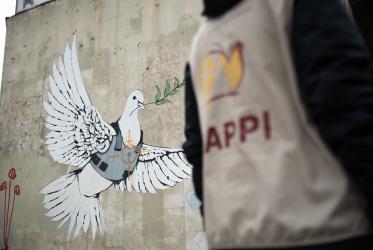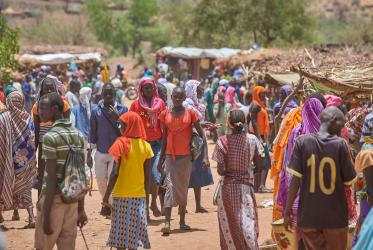By Ruth Lee (*)
Can you think of a time when you last heard the words "child abuse" and "church" used together in a sentence that did not refer to a high-profile scandal involving a church leader who had sexually abused children? It is almost impossible to think of such an example, particularly considering the deluge of stories in the media about church-related child sexual abuse over the past few years. As a result, an accusing spotlight has shone on the inadequacies of systems within churches to protect children entrusted into their care from abuse. Church institutions have been exposed as having turned a blind eye to, or even attempted to cover up, internal cases of child abuse.
In reaction to this, many churches have been falling over themselves to introduce child protection policies into all aspects of their work with children. So much so that it almost seems that today, a mother wanting to lend a helping hand at her child's summer scout camp has to fill in long and complicated forms and go through a vigorous police check before she is declared fit to teach the intricacies of knot-tying and to initiate songs around the campfire. Of course, these steps - strides in many cases - towards better child protection are going in the right direction. Doubtlessly, children at Sunday School or in the church choir are much safer when a child protection policy is in operation. And it is vital that all churches shake off their self-righteousness, admit that children have been abused by a system often more interested in protecting itself than the children themselves, and set up and implement stringent policies on child protection.
This is all well and good. But the nagging doubt does remain whether churches would actually have started out on the journey of taking child protection seriously at all had it not been for the extensive negative media coverage. In any case, does the ensuing focus and attention on protection policies go deep enough to really protect our children from abuse? Or is it, in a way, contributing to a neglect of the root causes of child abuse in our churches and in our communities?
At this point, we need to remember that, all too often, there is a tendency to equate "child abuse" with "child sexual abuse" and to forget that there is a much wider definition: "physical or mental violence, injury or abuse, neglect or negligent treatment, maltreatment or exploitation, including sexual abuse." Throughout the world, thousands of children are facing various forms of abuse every day. They are trafficked as a commodity of labour or sex, they are forced to work in hazardous mines and factories or fight for armies, they experience the horrors of war, they are forced to live on the streets, they are separated from their families by war or by HIV/AIDS, they are exposed to violence in their own homes and schools, the list goes on… These are cases of abuse that we rarely hear about, compared to the frequency with which they occur, and that the media hardly follows. Most of these children suffer in silence, and yet the impact on their lives is all too real; leading to death or suicide, to poor physical and mental health, to homelessness, to estrangement from family and friends, to difficult or abusive relationships as an adult, or to a sense of hopelessness.
Are you ready to hear some stories shared at some recent consultations in Asia on these issues? Do you want to hear the story of a traumatised Afghan boy, who, when he arrived at the Kabul rehabilitation centre where Nijabat Khan works, was not able to speak for several years and shook physically, due to having witnessed his parents being killed by a bomb that had fallen on their house? Or the story of a Cambodian girl, now in the care of Marie Cammal's refuge "Sok Sabay", who, after being sold to a brothel by her uncle, experienced rape at least 20 times a day and beatings if she resisted? What about the story, which Father Damien from Jaffna, Sri Lanka, tells of the continuous struggle of a girl he was counselling to deal with being raped by three gunmen who broke into her family home one night when she was fourteen years old? Or how about the situation witnessed by Father K.U. Abraham, where two children in his diocese in India under pressure from their community were banned from school because their parents had both died of AIDS? Or what about the stories that can be told by the house parents of a children's home in a popular beach resort in Thailand who rescue numerous children from sexual exploitation by foreign tourists?
Or perhaps you would prefer not to hear them? For they alert us to the fact that, although we are outraged by such stories, efforts to prevent abuse are all too often met with resistance at all levels of society, from governments to community/religious leaders to parents. This is because child abuse occurs mostly in private and is associated with criminality and corruption. The sad reality is that it is all too often publicly denied and yet privately tolerated. Nowadays, there are many child protection mechanisms, international, national and local, but the gap between such laws and what children experience on a daily basis remains enormous.
All this puts the question "are churches doing enough to protect children from child abuse?" in a very different light. Just because a protection policy, important as it is, is in place, it does not mean that child abuse has been prevented. A comparison of the concepts of "prevention" and "protection" hints at the duality of these interdependent approaches to putting a stop to child abuse: the latter is more curative whereas the former demands a deeper look at the reasons why child abuse occurs in the first place. As well as putting into place important protection mechanisms, churches have a vital role to play in addressing the factors which contribute to the risk of child abuse, be they social structures based on gender, economics, caste or class, other environmental stresses, war and conflict, discrimination, the family situation (the absence of one or both parents, for example), difficulties in relationships, depression or mental health problems, or the place of children in society in general. It is perhaps this last point which is the most important of all. Children are especially vulnerable to violence, exploitation and abuse precisely because of their vulnerability to and dependence on adults. It is when conditions are conducive to the misuse by adults of their inherent position of power in relation to children that children are abused.
I am writing this feature to mark the "World Day of the Prevention of Child Abuse" on 19 November, which aims to contribute to the creation of a culture of prevention of child abuse. An NGO coalition has been formed to mark 19 November and to raise awareness, mobilize public opinion and action, and disseminate information about child abuse prevention programmes. The wide range of prevention initiatives that this coalition represents reminds us, on the one hand, of the wonderful work which some churches and other civil society actors are currently involved in, and, on the other, of how much more churches potentially can and should do, both within churches themselves and in their wider communities.
As a member of this coalition, finding creative ways to accompany its member churches in affirming the right of children to live lives of peace should be a crucial role for the WCC. Two examples of current efforts are:
· the "On the Wings of a Dove" campaign, which will run from 25 November until 10 December 2004 to highlight the issue of violence against women and children,
· and the "Dignity of Children" programme in Asia which aims to create space for its member churches in Asia to reflect together with other civil society actors upon their role in affirming the dignity of children.
Over my two years at WCC, I have been involved primarily in the latter of these initiatives. I have seen that this process of networking can lead to exciting new initiatives to heighten church involvement in children's issues. There are so many churches throughout Asia engaging practically with the everyday needs of children in their communities, through the running of orphanages, drop-in centres, street children shelters, Sunday Schools, etc. For such churches and church-related NGOs, the chance to meet with others and share experiences is invaluable, as it gives them the possibility to make their voices heard by the larger church community and its leaders, calling them seriously to address the problems facing children.
Regional, sub-regional and national network consultations have empowered churches in Asia to deepen their analysis of the situation of children in their communities from various theological and cultural perspectives, and have equipped them to advocate actively for change in the structures of society which undermine children's dignity - structures which undeniably include churches themselves. A few of the national networks have focused particularly on the issues surrounding the prevention of child abuse:
· The network in Indonesia has dealt with the issue of protection and has recently published, in Bahasa, a book of "Guidelines for Churches on Children in Need of Special Protection".
· As a result of a national consultation in Malaysia in 2002 on "Children's Dignity and Protection", a "Sunday School Curriculum on Child Safety Protection" was devised for use in local churches with the dual aims of educating children to be aware of their rights and what to do in the face of sexual abuse, and of preparing church leaders to handle disclosure and to play a role in the healing process for the victim and family, as well as the offender.
Such initiatives are small yet valid steps towards building a culture of prevention of child abuse. In many places, policies on child protection are an integral part of what is needed for this, but we should not get bogged down in legislation only. In order to have long-lasting results, initiatives need to be rooted in cultural and social reality and be seen as part of a process of holistic transformation of society and of the world. The role for the church - and other faith communities - to play in this is vital and pressing.
And if we take up this challenge, perhaps one day the words "child abuse" and "churches" may conjure up a slightly more positive image than they do now…[1858 words]
- - -
(*) Ruth Leehas been working for the WCC Asia Desk on the Dignity of Children Programme for the past two years. In December 2004 she will take up the post of Social Policy Officer for the Mothers' Union in the UK.
For more information on the "On the Wings of a Dove" Campaign, click on:
For more information on WCC Dignity of Children programme, click on:
www.wcc-coe.org/wcc/what/regional/index-e.html
For more information on the World Day of Prevention of Child Abuse - November 19th, click on:
Opinions expressed in WCC Features do not necessarily reflect WCC policy. This material may be reprinted freely, providing credit is given to the author.






